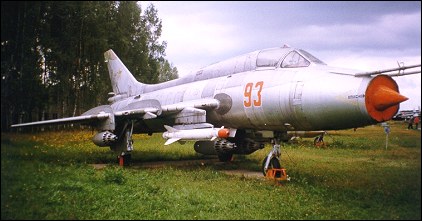|
| The Su-17 (S-32) single-seat ground attack fighter was the product of an extraordinary process of incremental redesign of the Su-7B (S-22). Under the leadership of Nikolai Zyrin, the Sukhoi OKB adapted an Su-7BMK as a low risk, low cost variable wing geometry demonstrator. Mid-span pivot points were introduced so that the outer wing panels could be sweptback from 28° to 45° and 62° positions. As the Su-7IG (Izmenyaemaya Geometriya, or variable geometry), or S-22I, the demonstrator flew on 8 August 1966, proving the efficacy of the variable-geometry arrangement and providing the basis for a production aircraft, the Su-17. This entered the VVS-FA inventory in 1970. The Su-17 was powered by the Lyulka AL-21F-3 turbojet with a military power of 7800kg and 11200kg with afterburning. Maximum external stores load was 4000kg distributed between nine external stations, and built-in armament comprised two 30mm cannon. An upgraded version, the Su-17M (S-32M), entered production in 1974, this having a drooped and lengthened - by 38cm -fuselage nose with ventral Doppler navaid pod. This, like the preceding Su-17, was exported as the Su-20 (S-32MK), recipients including Algeria, Egypt, Iraq, North Korea, Vietnam and Poland. A further export derivative using the basic Su-17M airframe, but re-engined with a Tumansky R-29BS-300 augmented turbojet with a max thrust of 11500kg, received the designation Su-22 and was supplied to Angola, Libya and Peru. Featuring a deeper forward fuselage and enlarged spine, and a redesigned tail to restore yawing stability, yet a further single-seat version, the Su-17M-1, appeared in mid-1979. The Su-17M-2, which appeared almost simultaneously, differed in equipment fit, with the export version, the Su-22M-2, supplied to both Libya and Peru, having the Tumansky engine. The definitive single-seat production versions were the Su-17M-3 and M-4, the former supplied to Hungary as the Su-22M-3 and the latter to Afghanistan, Czechoslovakia, East Germany and Poland as the Su-22M-4. These AL-21F-powered models embodied much improved avionics and introduced extra stations for R-60 or R-73 close range AAMs. With more than 3,000 built, including two-seat training variants, production of the Su-17 terminated in 1984.

| MODEL | Su-17M-4 |
| CREW | 1 |
| WEIGHTS |
| Take-off weight | 19500 kg | 42990 lb |
| DIMENSIONS |
| Wingspan | 10.04/13.66 m | 33 ft 11 in / 45 ft 10 in |
| Length | 19.10 m | 63 ft 8 in |
| Height | 4.86 m | 16 ft 11 in |
| PERFORMANCE |
| Max. speed | 2220 km/h | 1379 mph |
| Range | 2300 km | 1429 miles |
 | A three-view drawing (1653 x 1097) |
| hardy, e-mail, 13.01.2016 07:06 I am sourcing for su 22. Any lead / reply | | Mr Paul Baker, e-mail, 03.12.2015 13:25 Hi guys
When you de mill these aircraft!
Is it only the gun you remove or are the pylons and targeting system still intake for the bombs and rockets
Are the rocket launchers classed as non weapons reply | | Kiril, e-mail, 05.04.2010 01:35 I am able to offer demilitarized Su-17s for sale to civil buyers. Contact me for more information.
E-mail: chochkov@aero-x.eu reply | | Kiril, e-mail, 04.10.2009 18:16 I can supply Russian demilitarized Su-17 for sale to civil buyers. Contact me for more information. reply | |
| | Barry, 05.06.2009 17:53 The data and information above is full and detailed. However you mention that export models were known as Su22.Whilst it is true that this model was exported so was the Su17, the difference was that the Su22 was a variable geometry (swing wing)later build aircraft based on the earlier Su17. I beleive that the production figures above are inclusive of both models which incidentally both flew with the VVS. reply |
|
Do you have any comments?
|
| 
COMPANY
PROFILE
All the World's Rotorcraft
|








